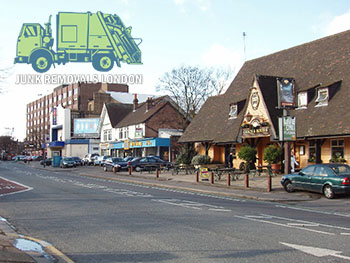The Borough of Hounslow is located in the outer parts of London and has a population of over 265.000 people. It covers an area of 21.61 square miles and shares common boundaries with the boroughs are Ealing, Hillingdon, Hammersmith and Fulham, and Richmond upon Thames.
Hatton is one of the smallest district within the Borough of Hounslow. It lies on the southern perimeter of Heathrow Airport which is the largest airport in the United Kingdom. The area is known for its numerous industrial buildings which were specially constructed to serve Heathrow. The presence of the airport has made Hatton, TW14, a least desirable residential district due to the high noise levels produces by the departing and arriving airplanes. The district is served by its own tube station which was opened in 1975 and sits on the Piccadilly Line from the London Underground. The latest numbers show that it provides transportation services to over 3.2 million people on an annual basis.
Gunnersbury, W4, lies in the easternmost parts of the borough and consists mostly of pre-World War II edifices. The BSI (British Standards Institution) Building is perhaps the area’s most popular landmark. It was built during the second half of the 20th century and comprises of 18 floors. Underneath the structure is located the district’s main transportation hub, the Gunnersbury station which dates back to the late 1860s. It serves the London Overground and London Underground and is used by over seven million people yearly. Other notable sites in Gunnersbury are the Russian Orthodox Church, the 18th century temple at Gunnersbury Park and The Gunnersbury which is one of the city’s most notable public houses.
The suburban district of Cranford covers an area of 1.05 square miles and is home to over 12.000 people. It lies at about 13 miles from the junction of Charing Cross and shares common boundaries with Hayes from the north, Heston from the east, Hounslow from the south and Harlington from the east. During the years several famous people such as Elizabeth Carey, Ian Gillan, Charles Scarborough, Jim Sullivan, and Tony, Lord Berkeley and Lord Gueterbock have lived in Cranford, TW5. The area is served by several bus routes while the nearest rail links are situated in the mentioned adjacent districts.
Hanworth, TW13, is both an urban and suburban district which lies in the westernmost parts of Hounslow. Over 23.000 people live in the area which spreads over 2.66 square miles. The district was once the site of the Hanworth Aerodome which played an important role during both World Wars. It was also at the Hanworth Aerodome that Amelia Earhart landed for the first time in England. All Saints Church, Tudor House and St. George’s are currently the district’s most famous places of interest. Despite its size and population, Hanworth doesn’t have its own tube or rail station. However a total of six bus routes serve the area and link it with the other parts of the English capital.
The district of Lampton is one of the smallest areas in the Borough of Hounslow. The district is mainly inhabited by commuters who work in the other parts of London. Until the 19th century, Lampton, TW3, was a rural area. Its development began when the Piccadilly Line from the London Underground Network was expended to the borough. Lampton Park and Lampton School are the district’s most notable sites. The lack of any major landmarks has made the area a calm and peaceful residential neighbourhood.
 Hounslow, TW4, is the principal town and district in the borough. It has a population of over 65.000 and lies at about eleven miles from the intersection of Charing Cross. The area is home to several well-known places of interest such as:
Hounslow, TW4, is the principal town and district in the borough. It has a population of over 65.000 and lies at about eleven miles from the intersection of Charing Cross. The area is home to several well-known places of interest such as:
- Blenheim Centre
- Holy Trinity Church
- Jersey Gardens
- Hounslow Railway Station
- Hounslow East Tube Station
- Osterley House
It is also the location of Hounslow Hearth one of the largest and most beautiful parks in the English capital. It spreads over an area of 82 hectares and is classified as a local nature reserve.
The town of Brentford is another major local district. The Syon Estate is beyond any doubt the most famous landmark of the area. It is the official residence of the Duke of Northumberland and was designed by prominent English architect, Robert Adam during the mid-18th century.
